- Back to Home »
- Tourism »
- Tourism Objects of Banten Province
3.08.2015
Banten
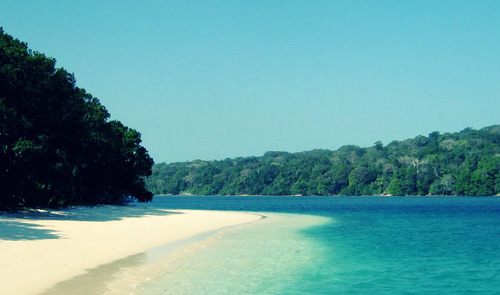
Banten is one of the young provinces in Republic of Indonesia. This region is situated in west Java. It can be reached about an hour from Jakarta. It's feel unbelievable, after the busy toll-way and hectic Jakarta as metropolitan city; we enter small and charming Banten. This city has a lot of treasure to whom that likes history. Such as the ruins of Surosowan Palace, Kaibon Palace, 'Masjid Agung Banten' [Banten Great Mosque, enlisted in Moslem's pilgrimage in Indonesia], Speelwijk fortress and Chinese temple Avalokiteshvara, and the harbor of Banten, Karanghantu [devil rock's harbor] that still used nowadays already existed since centuries ago. From this place, Sultan Banten's troopers took fight against the pirates and take defense from the Dutch.
Along with the prevailing regional government changing, in respect to the insistence of Banten People's aspiration to demand the separation from West Java Province, and after long process based on Law Number 23 Year 2000 concerning on Formation of Banten Province dated 17th October, 2000, established Banten Province as the 30th Province. Banten Province consists of 4 Regencies and 2 Cities, 94 Districts, 128 sub districts and 1,339 Villages. Geographically, the location of Banten Province is strategic because of the link between Java Island and Sumatra Island as well as the capital of Republic of Indonesia and West Java Province as a potential market of Banten's products.
The economic sector, that have a great potential resources and various to be developed, namely sectors in agriculture, industry/trade, tourism, mining/exploration, and also supported by the availability of variety natural resources in great amount. Industry sector contribute more than 52 % from total of Banten's GRDP, because in Banten there are 17 Industrial Zones equipped by good facilities and managed by professional private companies.
Banten is one of the newest provinces in Indonesia and also one of the richest. The province combines many of the most important Industrial Zones in Indonesia and also has the extended recreation areas along the western coast of Java and in south the Ujung Kulon National Park and the mountainous areas that are home to the Baduy people. Banten has the easiest access to Jakarta being merely an enclave in this province.
This province uses its own unique culture and language, both called Sundanese that is also used to call its people. The ancient kingdoms of Banten are Tarumanegara, Pajajaran, Banten and Cirebon would make interesting studies for the student of archaeology. Cirebon is located on the border between West and Central Java, having a mixed culture originating from the ancient Cirebon and Banten kingdoms, resulting in similar customs and dialects of the two people, although Banten city is located at the extreme western part of the province. Banten city on Banten Bay was one of the first places to begin trade with the Dutch. There is little to see of the past glories of this area today with the exception of the Grand Mosque, which was completed in 1599 and is certainly worth a visit.
Tourism Objects of Banten Provinces
Surosowan Palace - Fortress
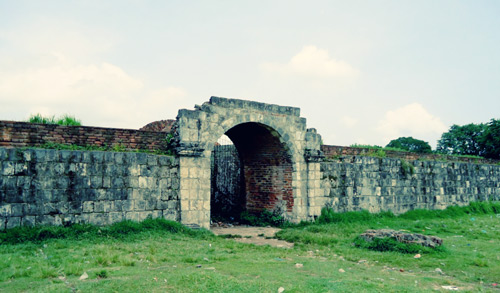
Surosowan Palace was built during the reign of Sultan Maulana Hasanuddin (1525-1552). Most of buildings were totally damaged during an attack lead by the Dutch Governor General Daendels in 1808. To the south of the square lay the impressive Surosowan Palace, designed by a Dutchman and later razed by his countrymen. The Surosuwan Palace was pulled down by blasted attack of Daendels because Sultan Syaifudin refused strongly of Daendels' order of Grootepostweg project that begun from Anyer to Panarukan and order to develop new port in Lada Bay. Even, Sultan flapped Du Puy off, a vice officer of Daendels, and sent his head to Daendels. Daendels was getting up set, and then he demolished the Surosuwan and Kaibon Palace. Now becomes ruins, leave the red bricks and several sites. Like water castle, the alleys and the moats.
Once upon a time the Palace covered an area of some 30,000 square meters with 2 meters high walls 5 meters thick and while the perimeter walls are still relatively intact inside looks like some cowboy builders have just tipped their bricks haphazardly round the site. Ground works are visible and a keen eye could probably make an educated guest mate as to how the Palace looked in it's former glory. The main entrance would have been on the northern side and in the European style there was a bastion on each corner protecting the flanks. Moats once encircled the whole but today just 2 remain, the southern one especially being a turgid, stagnant pond almost, creamy in color and foul in stench. Constructed in the mid 16th Century.
In front of the palace, there is a museum that houses artifacts discovered during the excavation at the palace. Museum closed on Mondays. The cannon Ki Amuk was located at Karangantu but is now installed in front of the Surosowan Museum. On the cannon Islamic inscriptions can be found, and around the muzzle, a sun is drawn, which reminds of the pre-Islamic kingdom of Majapahit. An old legend tells that one who is able to put his arms around the cannon will see all his wishes come true.
Kaibon Palace
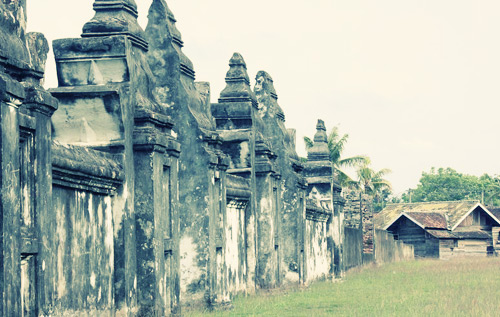
Refer to its name Kaibon, derived from word 'Ibu' (mother). This palace ruled by a queen for temporary. The palace name was coined from the fact that Sultan Muhammad Raffiudin (the last Banten sultan) built it as a gift to his mother, Queen Asyiah. Since the king who supposed to be in throne was not adult yet. Sultan Rafiuddin was 5 months old when he got the reign. Now remain the ruins with moats and Small River nearby and have gorgeous gateway.
Keraton Kaibon lies about one kilometer from the Banten Grand Mosque. This palace had erected in the early 19th century, it sits on an immense 15,000 square meters. The premises were broken into at the order of Dutch Governor General Daendels in 1813, (subsequently ending the sultan's reign) and then damaged by the Dutch in 1832. Today, the ancient walls, foundations, the gateway and main gate bear truth to the once-powerful Banten Sultanate. The admission of this area is free.
Banten Grand Mosque
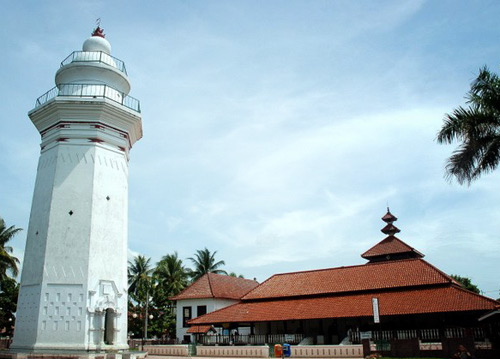
Sultan Maulana Yusuf founded the grand mosque in 1566; it has a five-layered roof and an eight-cornered minaret. Around the mosque there is a market that sold some foods and Islamic souvenirs. For Muslim's pilgrimage this place is something important. But for architectures visit also something worth, beautiful minarets and several Old Dutch buildings in the same area.
The Sultan of Banten in the mid 1500's was busy as he transferred the wealth the city created as a city-port into bricks and mortar which we see a legacy of today. As well as the Palace he had this mosque constructed and he himself is buried in the grounds to the north. The base is rectangular while the 5 tiered roof hints at earlier Hindu influences. The eye-catching minaret looks like a lighthouse and is visible from much of the local grounds. Its construction date is unclear while some rumor has it being built by a Chinese Muslim again in the middle of the same century.
Baduy Cultural Conservation
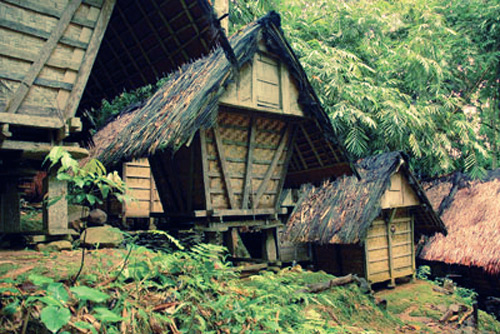
The Baduy community in Banten is an utterly unique and closed society, which can be reached via a 10 km village road from either Cibolegar or Cibungur village in Leuwidamar district. The 50 km road from Rangkasbitung is steep. In April and May, the Baduy community is closed to outsiders, as during this time it commemorates certain ceremonies, called Seba, the offering of part of their agricultural products to the Head of the District, Sub-Regent and the Chief Resident. During this ceremony the "Puun of Baduy" sends out a group of representatives of Baduy Dalam people as well as Baduy Luar to act as the community's spokesmen. When conducting this Seba ceremony the Baduy Dalam members refuse to ride any vehicle, instead, the distance of150 km is traveled on foot as proof of their perseverance. To enter this very special Baduy area, one should obtain written permission from the Rangkasbitung District Office stating the purpose of the visit, which may take one whole week to process.
The Badui
The Badui is a tribe of between 2,000 and 4,000 Sundanese speaking people living in 27 villages in the mountains south of Rangkasbitung. These people still have their own culture. They fight against attempts of the government to make them part of the modern world. Recently they won a struggle against western schools in their area. The culture is very impressive although it is not easy to learn something about this area and their people. There are three villages in the center of the area (Cibeo, Cikartawana and Cikeusik), which cannot be visited. Here live about 40 families of the purest Badui stock. The culture here is almost unharmed yet. The 24 villages in the outer circle are each connected to one of the inner three from which they are ruled. Three of these outer villages can be visited (Leuwidamar, Lebak and Kadukatug). Only visit this area if we are fit and used to adjust to local life forms. Bring food and gifts for the local people and enough money. It is advisable not to go with a group of more then eight people and to behave our self. Only then the people will accept us as a visitor. To enter the area we must first obtain a permit at the tourist office of Rangkasbitung at Pahlawan Street 13. From Rangkasbitung we have to find transport to the entry point of the Badui area at Cibolger. In Leuwidamar, we can stay the night at the police chief (kepala polisi). Give him a donation for the food and drinks. We can ask him also if he knows a guide who can bring us to some other villages.
Carita Beach

This beach is about a three-hour drive along the highway to the west of Jakarta, and has a great beach for swimming, as the waters are relatively calm on this side of the island. A great place for swimming, scuba diving, snorkeling, sailing, fishing, and underwater photography, this resort offers a complete set of facilities including restaurants, accommodation, motorboats, and diving equipments. This beach is located in West Banten, Labuhan district, Padeglang regency, which is accessible by any land transportation and takes about 3 hours drive from Jakarta. The parlous state of conservation in Indonesia, and in Java in particular means that this small, degraded forest behind this busy beach resort is one of the best places to find some of Java's lowland endemics. The forest has heavily used both by tourists (more high school students) and by local woodcutters and trappers. All the forest on the ridge tops appears to have been recently logged and this forest would appear to have a limited future - another victim of Indonesia's economic woes.
Besides white beaches behind hundreds of swaying coconut trees, one panoramic highlight is the visibility of the infamous Krakatoa Volcano from Carita, rising above the horizon in Sunda Strait between Java and Sumatra. The visitors won't have difficulties finding a place to stay here as many cottages, hotels and camping grounds are all available, not to mention the inevitable seafood.
Accessible from Jakarta over a fair road, the visitors can reach it in less than 3 hours, one third of which is over a toll road, which is being extended to the extreme western part of Java in Merak. Here again, most visitors arrive from Jakarta, as Bandung is more than 6 hours away from Carita by road.
Anyer Beach

Anyer is a beach town in Banten. It is located at Anyer, 38 km from Serang City. The beach is facing the West, so we can see the view of Mt. Rakata (the remaining / child of Mt. Krakatau that exploded in 1833) and the sunset. A beautiful sea sight with all activities such as Jet Ski, Speed Boat, Para Sailing and other aquatic sport, those types of activities can be found here, as well as sunset view from the beach and an old lighthouse at Cikoneng. A lot of hotels from jasmine to international 5 stars can be tourist best choices to stay. Anyer is a popular beach resort for Jakartan.
Anyer beach has many unique enchantments. Its white sands amaze many tourists. They are so pure; we can feel the softness of the sands. The deep blue sea attracts many divers around the world because its various sea lives are so completely perfect. The sea breeze can make visitors' mind fresh, out of stress and enjoy. And the last enchantments that can make Anyer beach as the most favorite place to visit is the view of the legendary Krakatau Mountain and its historical lighthouse.
It is located in the west coast of Java about 120km from Jakarta. Sanghyang, 10 km off Anyer beach, is an easy diving destination for Jakartan divers who can only spare a weekend. This volcanic island offers white carbonate-sand beach and a wealth of underwater life, while Anyer offers a gorgeous sunset.
Karang Bolong Beach

The name Karang Bolong means Rock (Karang) with a Hole (Bolong). This may have been some frozen lava, formed during the eruption of Mount Krakatau. Karang Bolong beach is the beach recreation area where there is a big rock with its hole in the center, facing the open sea. The Rock forms a gate facing the sea, making it look very picturesque. There is a small forest, which has been converted into a recreation spot. There is a river flowing down to the sea where people can have a bath of fresh water after swimming in the salty sea. Karang Bolong beach is located 50 km from Serang town or 140 km from Jakarta, on Karang Bolong Street.
Salira Indah Beach
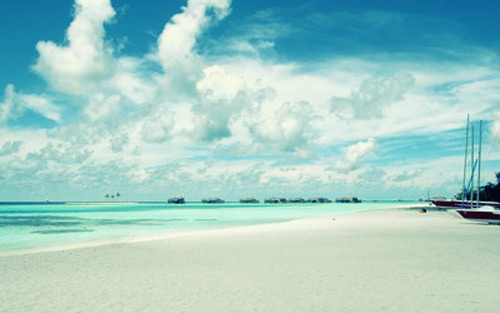
About 15 km from the Merak bus station is Salira Indah beach resort, located at scanning Tanjung Pujut. This resort on Java's west coast can easily be reached within a few hours from Jakarta either by bus or car.
Krakatoa Volcano
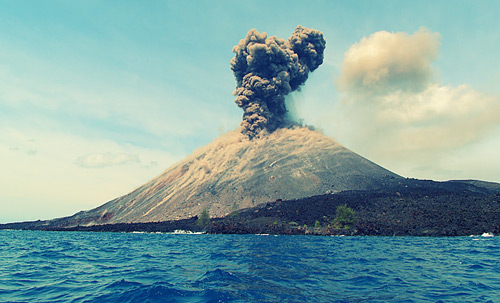
Actually the Krakatoa / Krakatau belongs to Bandar Lampung, a province of Sumatra. But the Krakatoa is most easy to reach from Java and is part of Ujung Kulon national park in the south west of Java so Krakatoa is implemented in Java section. Krakatoa is one of Indonesia's most active volcanoes that located in the strait between Sumatra and Java. With devastating effects this volcano erupted just over a century ago in 1883, bringing its fine ashes with the wind streams as far away as over New York City, whereas the eruption's tidal waves reached the American West Coast. At that very instant, Krakatoa vanished as if devoured by the sea, causing formidable tidal waves which in turn swept off just about everything alive from the surrounding coastal areas. However, the disappearance of the gigantic Krakatoa also meant the birth of small islands in its place, one of which is called "Anak Krakatau" or Krakatoa's Child, which is at present an extremely active young volcano. From both West Java's, West Coast, and from Sumatra's Lampung Province, this young and very active volcano is clearly visible. A boat trip to this place may be worth making.
A unique location is in the middle of Sunda strait. It's a little volcano pierce from the ocean. Krakatoa could be reached from Anyer or Carita beach. Approximately 2 hours cruising on a speedboat and 3 and half hour on a slow diesel boat. There are three islands surrounding Anak Krakatau. All of these islands seem to be parts of big Krakatoa before the big eruption in 1883. That's why there are a few lagoons caused by the eruption. These lagoons were a home for Giant Trivially, Red Snapper, Grouper and many others reef fishes. Besides fishing, the visitors are also can enjoy the scenes of Mount Krakatoa that also amazing.
Ujung Kulon National Park

Ujung Kulon National park is an isolated untamed wilderness on the southwestern tip of Java. The Dutch opened this park in 1921 to protect the threatened Javanese rhinoceros. Now the area covers about 760 sq km including Panaitan Island. It is one of the best places in Java for wildlife spotting. There are many kinds of animal species, which can be seen. They are birds, wild pigs, hornbills, river otters, deer, crocodiles and the Javanese rhinoceros. The crocodiles and the Javanese rhinoceros are rare seen but we never know.
The best time to visit Ujung Kulon is between April and October. To get there and to get information about the park the visitors have to go to Labuhan where the PHPA at the coastal road can give us all information and arranges our permit for the park. An entry permit is needed, issued by the Forestry Service / PHPA (Perlindungan Hutan dan Pelestarian Alam) at Labuan. From here we can also take the boat to Ujung Kulon. The boat leaves on Mondays and Fridays and returns on Sundays and Thursdays.
Handeuleum Island is at the northern bay of Ujung Kulon and offers also a small guesthouse. Peucang Island at the western tip of Ujung Kulon also has a guesthouse and also a small restaurant. Marine life in the surrounding seas is a kaleidoscope of colors. Beautiful sea gardens are found off Peucang and Panaitan islands. From one of these two islands we can start to explore the park. In the park are several posts of the PHPA where we can stay over for the night. If we want to hike in the park we must hire a guide from the PHPA in Tamanjaya. It is wise to bring our own food and sleeping back if we want to stay over for the night in the park. If we want to walk around the whole park along the tracks it will take us about 3 three days (45km). On the western tip of the peninsula is a lighthouse built by the Dutch, which stands near the site of the ruins of the old one.
Dua Island
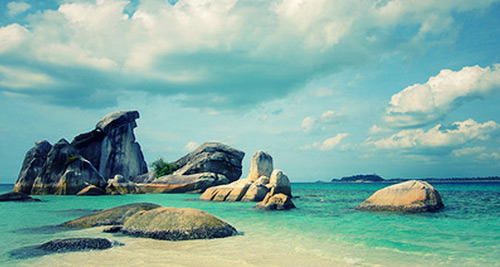
Dua Island (Pulau Dua) is the name of a small nature preservation inhabited by some 50 kinds of fish-eating birds. It is located in the Banten bay and is accessible by boat from Tanjung Priok sea harbor or from Marina, Ancol.
This pristine island is also one of Indonesia's major bird sanctuaries, where more than 50,000 birds stop over during the winter or breeding season. Among these migratory creatures include egrets, ibis, teals, kingfishers and pelicans, while herons, storks and cormorants are some of the permanent residents. These birds originated from Africa, Asia and Australia and stay on this island to lay and hatch their eggs during April through August each year and fly back home afterwards. Little wonder, then, that this natural heaven is also known as Pulau Burung (Bird Island). The island is a hop away from Banten old town and can be accessed by walking on the shoal during low tide. The visitors can take a boat to get there quickly and safely.
Avalokiteshvara Chinese Temple
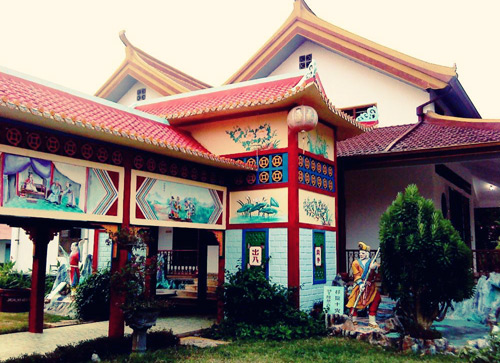
Avalokiteshvara temple is the oldest Chinese temple in Banten. This temple is built around 1860 and successfully renovated at 1930. It's so unique place, since it situated in the front of Speelwijk Fort. The visitors can stay here during their trip to Banten. Simple and humble place to stay but it's one of the option whenever we're in Banten.
Speelwijk Fort and Cemeteries
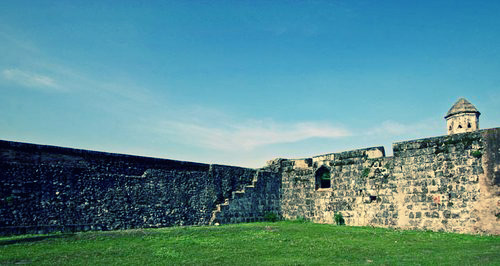
This fortress is sited in the north west of Surosowan, Pamarican village. Fort Speelwijk was built in 1682 by VOC and expanded in 1685 and 1731 to control the activities of the Banten kingdom and protect the Dutch interests at Banten. Situated not so far from Chinese temple Avalokiteshvara, this fortress directly facing to the sea. From this point, the Dutch troopers was watching and guarding the fort from pirates and local heroes. Inside the fortress, there's an Old Dutch cemetery. One of the buried bodies is a man who was born in Bergen-op-Zoom in 17th century. The Ruin of fortress implies that it was a great fortress in Banten, height about 5 meters and length of each side of 80 meters; also the canal for defense surrounded it. It has four bastions that still stand sturdily.
In 1659 a treaty between Banten and the Dutch, by then a trading company known for short as VOC, gave a tract of land free to the Cloggiest and it was here they built their stone defenses. At that time the sea was much closer than today, now fishing boats are just visible bobbing lazily on the tide from the battlements. In 1682 after a brief conflict the Dutch kicked the English traders out of 'their' turf and licking their wounds, they settled on the godforsaken Bengkulu on the west coast of Sumatra where they proceeded to drink vast quantities of alcohol and really piss off their head office in London.
Just outside the fort to the east are some tombs of those who never made it home. Like can be seen in Jakarta, Bogor, Penang and Melaka the silent tombs tell the story of western endeavors in the east and it is to the credit of the host countries that these burial places have often been spared the bulldozer. The ruin of Speelwijk fort is also stayed at the northwest of the tomb of the third king of Banten kingdom, Maulana Yusuf, who ruled in the 1570s. Since 1985, local archaeological finds have been displayed in the Banten Site Museum on Mesjid Banten Lama Street.











